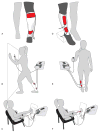Pulse Width Does Not Influence the Gains Achieved With Neuromuscular Electrical Stimulation in People With Multiple Sclerosis: Double-Blind, Randomized Trial
- PMID: 29366377
- PMCID: PMC5811347
- DOI: 10.1177/1545968317753681
Pulse Width Does Not Influence the Gains Achieved With Neuromuscular Electrical Stimulation in People With Multiple Sclerosis: Double-Blind, Randomized Trial
Abstract
Background: Multiple sclerosis (MS) eventually compromises the walking ability of most individuals burdened with the disease. Treatment with neuromuscular electrical stimulation (NMES) can restore some functional abilities in persons with MS, but its effectiveness may depend on stimulus-pulse duration.
Objective: To compare the effects of a 6-week intervention with narrow- or wide-pulse NMES on walking performance, neuromuscular function, and disability status of persons with relapsing-remitting MS.
Methods: Individuals with MS (52.6 ± 7.4 years) were randomly assigned to either the narrow-pulse (n = 13) or wide-pulse (n = 14) group. The NMES intervention was performed on the dorsiflexor and plantar flexor muscles of both legs (10 minutes each muscle, 4 s on and 12 s off) at a tolerable level for 18 sessions across 6 weeks. Outcomes were obtained before (week 0) and after (week 7) the intervention and 4 weeks later (week 11).
Results: There was no influence of stimulus-pulse duration on the outcomes ( P > .05); thus, the data were collapsed across groups. The NMES intervention improved ( P < .05) gait speed and walking endurance, dorsiflexor strength in the more-affected leg, plantar flexor strength in the less-affected leg, force control for plantar flexors in the less-affected leg, and self-reported levels of fatigue and walking limitations.
Conclusion: There was no influence of stimulus-pulse duration on the primary outcomes (gait speed and walking endurance). The 6-week NMES intervention applied to the lower leg muscles of persons with mild to moderate levels of disability can improve their walking performance and provide some symptom relief.
Keywords: force steadiness; multiple sclerosis; muscle strength; neuromuscular electrical stimulation; walking endurance; wide pulse.
Conflict of interest statement
The authors declare no potential conflicts of interest with respect to the research, authorship, and/or publication of this article.
Figures



Similar articles
-
Force control during submaximal isometric contractions is associated with walking performance in persons with multiple sclerosis.J Neurophysiol. 2020 Jun 1;123(6):2191-2200. doi: 10.1152/jn.00085.2020. Epub 2020 Apr 29. J Neurophysiol. 2020. PMID: 32347151 Free PMC article.
-
Motor unit discharge characteristics and walking performance of individuals with multiple sclerosis.J Neurophysiol. 2018 Apr 1;119(4):1273-1282. doi: 10.1152/jn.00598.2017. Epub 2018 Jan 3. J Neurophysiol. 2018. PMID: 29357453 Free PMC article.
-
Progressive resistance training did not improve walking but can improve muscle performance, quality of life and fatigue in adults with multiple sclerosis: a randomized controlled trial.Mult Scler. 2011 Nov;17(11):1362-74. doi: 10.1177/1352458511409084. Epub 2011 Jun 15. Mult Scler. 2011. PMID: 21677021 Clinical Trial.
-
Artificial Walking Technologies to Improve Gait in Cerebral Palsy: Multichannel Neuromuscular Stimulation.Artif Organs. 2017 Nov;41(11):E233-E239. doi: 10.1111/aor.13058. Artif Organs. 2017. PMID: 29148138 Review.
-
Contributions to the understanding of gait control.Dan Med J. 2014 Apr;61(4):B4823. Dan Med J. 2014. PMID: 24814597 Review.
Cited by
-
Force control during submaximal isometric contractions is associated with walking performance in persons with multiple sclerosis.J Neurophysiol. 2020 Jun 1;123(6):2191-2200. doi: 10.1152/jn.00085.2020. Epub 2020 Apr 29. J Neurophysiol. 2020. PMID: 32347151 Free PMC article.
-
Neuromuscular Electrical Stimulation Does Not Influence Spinal Excitability in Multiple Sclerosis Patients.J Clin Med. 2024 Jan 25;13(3):704. doi: 10.3390/jcm13030704. J Clin Med. 2024. PMID: 38337396 Free PMC article.
-
Interventions to improve outdoor mobility among people living with disabilities: A systematic review.Campbell Syst Rev. 2024 Jun 14;20(2):e1407. doi: 10.1002/cl2.1407. eCollection 2024 Jun. Campbell Syst Rev. 2024. PMID: 38882933 Free PMC article. Review.
References
-
- Sandroff BM, Sosnoff JJ, Motl RW. Physical fitness, walking performance, and gait in multiple sclerosis. J Neurol Sci. 2013;328:70–76. - PubMed
-
- Snook EM, Motl RW. Effect of exercise training on walking mobility in multiple sclerosis: a meta-analysis. Neurorehab Neural Repair. 2009;23:108–116. - PubMed
-
- Motl RW, Pilutti LA. The benefits of exercise training in multiple sclerosis. Nature Rev Neurology. 2012;8:487–497. - PubMed
-
- Coote S, Hughes L, Rainsford G, et al. Pilot randomized trial of progressive resistance exercise augmented by neuromuscular electrical stimulation for people with multiple sclerosis who use walking aids. Arch Phys Med Rehabil. 2015;96:197–204. - PubMed
-
- Broekmans T, Roelants M, Feys P, et al. Effects of long-term resistance training and simultaneous electro-stimulation on muscle strength and functional mobility in multiple sclerosis. Mult Scler. 2011;17:468–477. - PubMed
Publication types
MeSH terms
Grants and funding
LinkOut - more resources
Full Text Sources
Other Literature Sources
Medical

